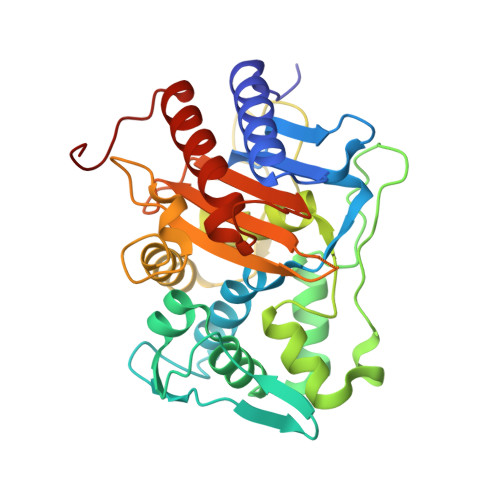Mutations in PBP2 from ceftriaxone-resistant Neisseria gonorrhoeae alter the dynamics of the beta 3-beta 4 loop to favor a low-affinity drug-binding state.
Fenton, B.A., Tomberg, J., Sciandra, C.A., Nicholas, R.A., Davies, C., Zhou, P.(2021) J Biological Chem 297: 101188-101188
- PubMed: 34529975
- DOI: https://doi.org/10.1016/j.jbc.2021.101188
- Primary Citation of Related Structures:
6XQV, 6XQX, 6XQY, 6XQZ - PubMed Abstract:
Resistance to the extended-spectrum cephalosporin ceftriaxone in the pathogenic bacteria Neisseria gonorrhoeae is conferred by mutations in penicillin-binding protein 2 (PBP2), the lethal target of the antibiotic, but how these mutations exert their effect at the molecular level is unclear. Using solution NMR, X-ray crystallography, and isothermal titration calorimetry, we report that WT PBP2 exchanges dynamically between a low-affinity state with an extended ¦Â3-¦Â4 loop conformation and a high-affinity state with an inward ¦Â3-¦Â4 loop conformation. Histidine-514, which is located at the boundary of the ¦Â4 strand, plays an important role during the exchange between these two conformational states. We also find that mutations present in PBP2 from H041, a ceftriaxone-resistant strain of N.?gonorrhoeae, increase resistance to ceftriaxone by destabilizing the inward ¦Â3-¦Â4 loop conformation or stabilizing the extended ¦Â3-¦Â4 loop conformation to favor the low-affinity drug-binding state. These observations reveal a unique mechanism for ceftriaxone resistance, whereby mutations in PBP2 lower the proportion of target molecules in the high-affinity drug-binding state and thus reduce inhibition at lower drug concentrations.
Organizational Affiliation:
Department of Biochemistry, Duke University School of Medicine, Durham, North Carolina, USA.

















